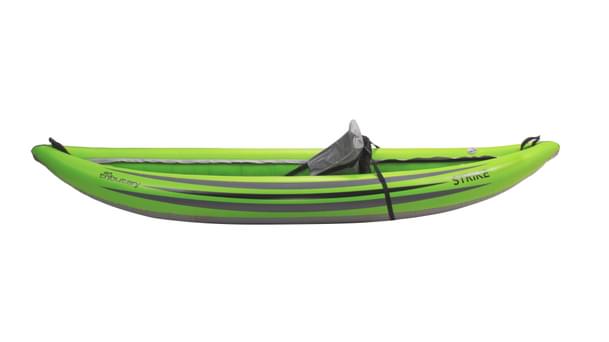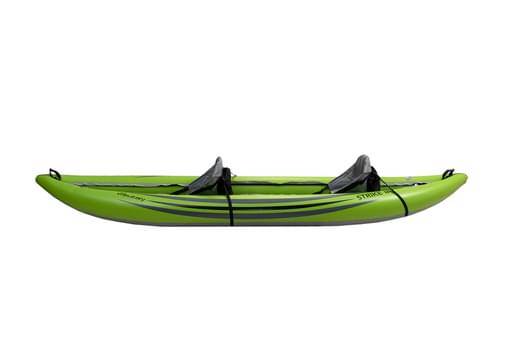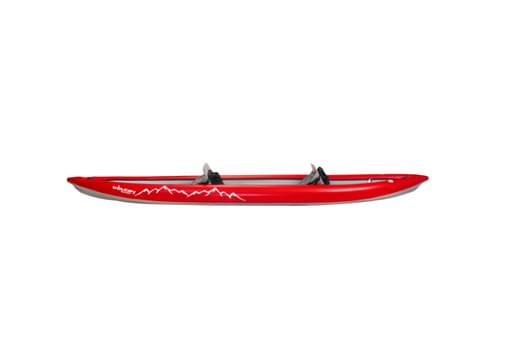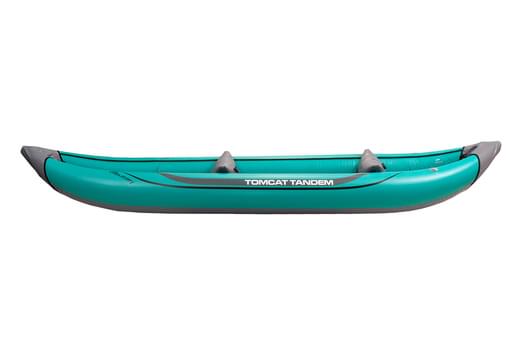- Home
- Gear & Reviews
- Arluk 1.9
Arluk 1.9
This Product Has Been Discontinued
Arluk 1.9 Description
The Arluk 1.9 is a kayak brought to you by Necky Kayak. Read Arluk 1.9 reviews or submit your own review to share with the paddling community. Check out a few other kayak recommendations below or explore all kayaks to find the perfect one for you!
Necky Kayak
Arluk 1.9 Reviews
Read reviews for the Arluk 1.9 by Necky Kayak as submitted by your fellow paddlers. All of the reviews are created and written by paddlers like you, so be sure to submit your own review and be part of the community!
I bought my 1996 Kevlar…
I bought my 1996 Kevlar Arluk 1.9 from a friend several years ago, and she is still in fantastic all-original shape. I paddle in Southern California, and go on expeditions in Baja. My two cents:
I find this boat reasonably stable, fast, light-weight, and beautiful.
She holds plenty of gear and weight; however, the bow and stern are more slender than most other Neckys, so you have to pack carefully.
She is quite maneuverable with rudder, and reasonably maneuverable without.
I believe she weighs about as claimed: about 48 lbs. I'm in my 60s and scrawny, and loading her on the roof of my car is no problem.
Now that Necky is gone (I'm still mourning their loss), if you own one of these rare and special boats, please maintain her, restore her, or pass her on to someone who will.
I recently purchased a Necky…
I recently purchased a Necky Arluk 1.9. It was manufactured in 1999 and has the light blue deck with dark blue hatch covers. Before the purchase I read reviews of this kayak on many different websites. There are many different lengths, widths, and weights for this kayak. But, according to my measuring tape, the Arluk 1.9 that I just purchased measures 217" in length not including the rudder and 21.5" wide at its widest point. I believe this boat is fiberglass. I don't know if there was a kevlar version.
I have taken it out twice . . .
Initial stability is twitchy as expected but I was accustomed to it very quickly. I launched from a pier, standing in water, and from a beach. It is very fast and glides very nicely. The kayak easily handled a 10 mph wind with a small chop on the sound. The boat tracks very well and the rudder definitely improves turning.
I really enjoyed paddling this kayak and I am looking forward to getting out again soon.
Classic Northwest style touring for mid-sized paddler
Amongst sea kayaks of a similar era the Necky Arluk 1.9 stands out as a classic. Necky does not build this boat anymore but they are available used. Necky built some different sizes of this hull concept but none of the other sizes had the impact and seaworthyness of the 1.9. There are some confusing models in this collection. I was in Canada and saw a Arluk 2 and another version of this boat with a smaller "ocean" style cockpit called the 1.8. The verson to look for used is the Kevlar build. Both deck and hull are vacuum bagged and have in some cases carbon fiber ribs placed at intervals for stiffness. The weight of my boat was only 46 lbs. Simple hatch systems with neoprene hatches covered with a fiberglass lid. The older boats may require new neoprene to be water tight.
This is a low volume boat best suited for a smaller paddler or women but I am a 6 foot 200lb guy and the boat is still a good fit. Because of the low volume it is a challenge to pack for a week long paddle. You will have to eat your way into the boat and if you have to carry water for any period the aft deck will be awash in water in the haystacks of a tide rip. The standard foam block seat is terrible. Easy to pull that out and replace. I got a molded plastic canoe tractor style seat and ground off the tabs and glassed in a block to receive the shape directly on the bottom of the boat.
The boat has the long bow overhang and sweeping lines, low fore deck and almost flush aft deck. The ski shaped bow is perfect for running up on beaches and the flat transom will carry a strong rudder. The narrow beam and flared hull make this boat feel tippy to the novice but to an experienced paddler this boat feels perfect. Loaded onto its touring water lines it gets super stable and feels great. This is a rudder boat and in my view paddled best with the rudder deployed. There is a lot of rocker in the hull which helps maneuverability and lower wetted surface.
If you are a larger paddler and looking for a boat of similar performance try looking at the Seaward Quest X3 or Guide version. The Quest is a similar concept, longer with more volume and a higher deck. I have since sold my trusty Arluk 1.9 to a local female paddler after paddling my boat for almost 15 years on the rugged west coast of Vancouver Island. 2 years ago I decided I needed more volume for longer distance paddling. We did a 108nm trip from Port Hardy via Cape Scott to Quatsino Sound and Coal Harbor. The Seaward Quest was a good step-up for me and delivered the volume and performance i needed to carry the load and still be super fast at sea. Other paddlers in our group bought the Current Designs "Extreme" which was great! There was also a Necky Tahasis with us that did well. We did the total trip in only 5 days with one down day at Cape Scott. These boats were paddled 30 to 37nm days in rough open ocean conditions and delivered us home save and secure.
paddle on lads....
The Arluk 1.9 is a…
Anyways, the outcome of designing the ends this way is that when in short steep swells/ chop the ends of the kayak sink into the crests in front and behind while the center portion of the kayak is resting in the trough thereby enhancing stability. This is very effective when in the narly stuff but I believe it contributes to broaching when surfing - the bow tends to cut too deep in the back of the wave ahead. Another outcome is that the Arluk 1.9 is alot less stable initially than many other kayaks with 22" beam and fuller ends.
The 1.9 rides low in the water - especially when loaded to the max. When starting out on a week - 2 week trip expect to get alot of water riding over the bow. The narrow bow pierces every wave vs. riding over it. It is very easy to edge into waves and edge for turning. It catches swells and wind waves easily and easy to keep surfing for long distances except in surf or steep, close-together waves where it perls into a broach. Once broached the 1.9 rests comfortably when the paddler is bracing on the face/backface of the wave while leaning into the wave.
The 1.9 comes with a rudder and probably most paddlers would need it. I find it weathercocks noticably - especially in the lee of low land where the water is flat but the wind strong. However, I took my rudder off mainly because I love the low profile of the stern - the rudder takes away from that beauty - but also because the 1.9 is very responsive to leaned turns (and very unresponsive when not leaned). I'd estimate that I could paddle a 360 degree circle with a diameter as tight as 25 ft using only forward alternating strokes and a constant lean - no sweeps, paddle-ruddering or other steering strokes. Having said that, I would caution taking the 1.9 on extended open ocean trips without the rudder - where you will encounter tides and rips and currents. The low volume ends can catch/trip on currents/rips more easily risking capsize. The rudder can really help by freeing your strokes up for power only strokes.
Gear volume is moderate. If you have to pack alot of your water and can't refill every night you'll be limited to a couple days. Otherwise you could stay out for two weeks or more if you can find fresh water every night.
Cockpit volume: I'm 6'1" tall with size ten and a half feet. I always have to have my feet angled out as they don't fit when straight up except right down the centerline. The cockpit opening is keyhole with pretty good grip for my knees tho' I glued rubber padding on the underside of the deck. I also cut off the coaming extensions that give the cockpit opening that 'keyhole' look - they were more a nuisance and my knees/thighs didn't touch them. The stock seat is a foam slab stuck right to the kayak floor with a foam covered plastic arch back rest. I didn't like it (especially the back rest) and replaced it with a slung homemade fiberglass bucket seat molded to my own butt. Behind the seat I installed an electric pump. Bulkheads are 2" closed cell foam. I'd like to replace them with 1/4" fiberglass-foam sandwich (while moving the forward bulkhead back about a foot! - alot of wasted space there right now plus more volume to pump out should the cockpit flood).
Gear hatches are large. Coverings are neoprene with fiberglass protective lids. Leakage is slight in very choppy water. About a cup from rolling practice.
Roll-ability is fair to good. I've found alot of other boats with greater volume at the ends easier to roll.
Deck layout could be better. Raised hookeyes are used to thread the safety lines and decklines - bad points there. Desperately needs recessed fittings. I've banged the damn things so many times. Foredeck is peaked (like an A), not flat or rounded. Pros: provides knee height while keeping minimum the extra volume in the cockpit.

